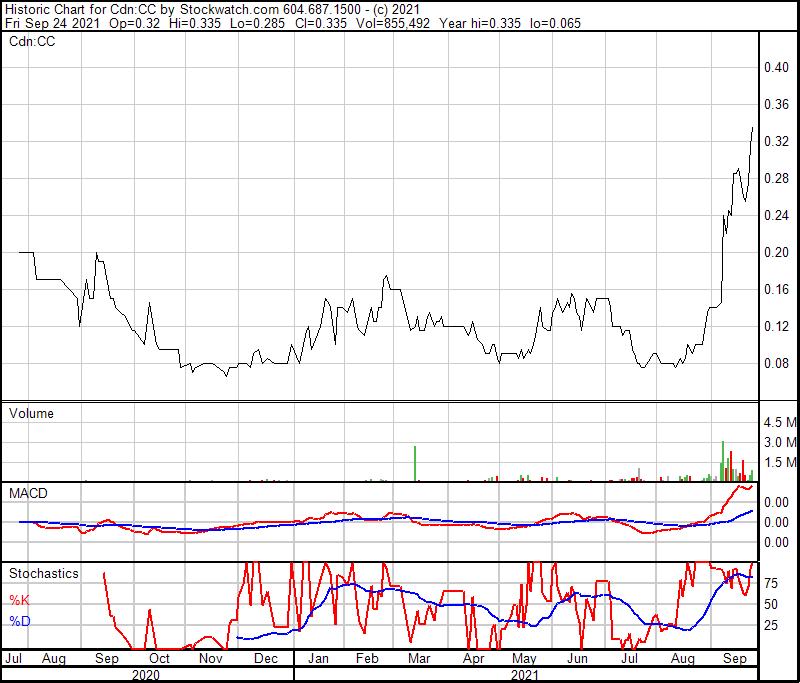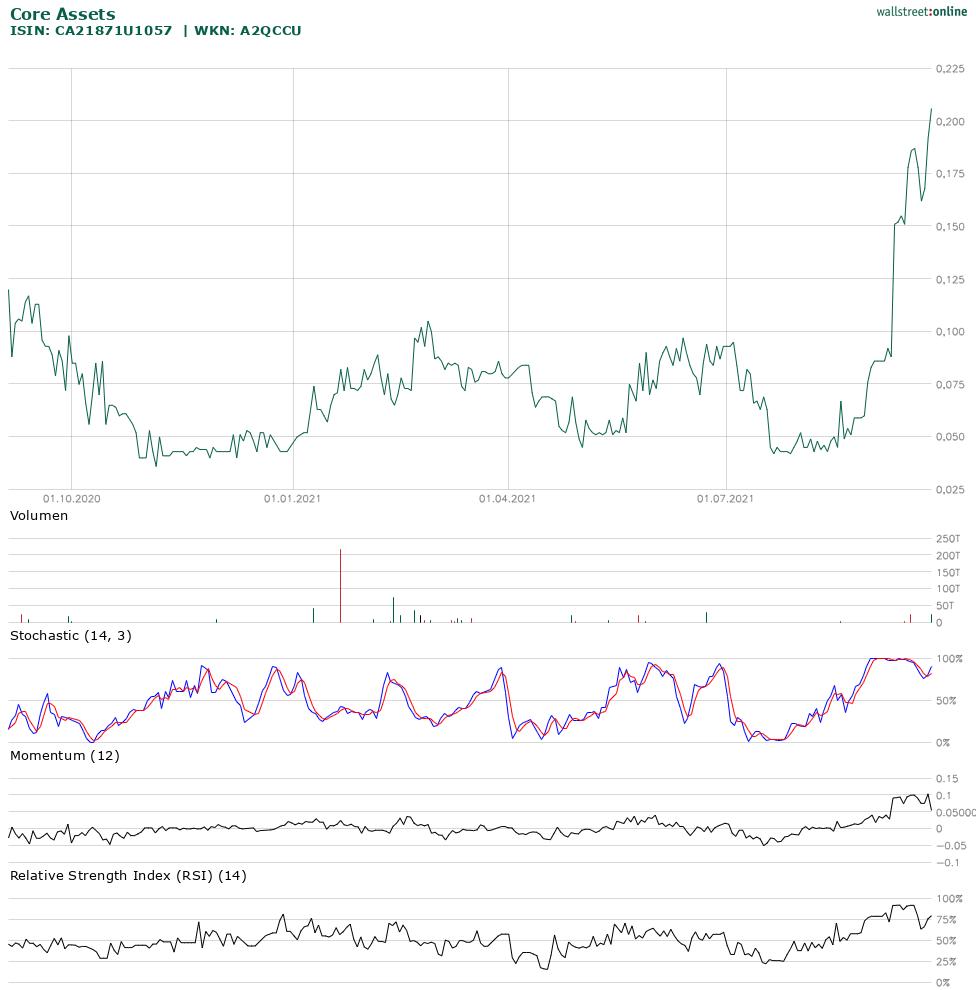Full size / Recent channel sampling at Core Assets‘ Blue Property, pending assays. (Source)
Disseminated on behalf of Core Assets Corp. and Zimtu Capital Corp.
As a result of “encouraging visual observations“ during its phase-1- and phase-2 sampling programs, Core Assets Corp. last week announced the expansion (quadruplication to 1083 km2) of its 100% owned, royalty-free Blue Property at the northern edge of the Golden Triangle in British Columbia (BC), Canada. The news was followed by a Rockstone report highlighting the chances of making a CRD (Carbonate Replacement Deposit) discovery and explaining the significance of CRDs in comparison with other types of polymetallic deposits such as VMS and MVT. Today, Core Assets released assays from its recently completed phase-1 grab-sampling program, when 247 grab samples were collected.
Core Assets noted in today‘s news: “Core Assets Confirms New Discovery at the Blue Property, Atlin, British Columbia... Strong mineralization was identified in numerous locations across the Property and Core Assets has now confirmed carbonate replacement mineralization at surface over an area 6.6km x 1.8km... with alteration assemblages indicating this is formed from a porphyry source. VTEM and Phase 2 channel sampling program results are expected to be released by late 2021.“
Shortly after the release of the news, Core Assets´ CEO and President, Nick Rodway, discussed the significance of today‘s results in a video-news-release:
Click above player or here to watch today´s video-news-release from Core Assets Corp.
Excerpts from Core Assets‘ news-release today:
Core Assets Confirms New Discovery at the Blue Property, Atlin, British Columbia
Vancouver, September 27th, 2021 – Core Assets Corp., (“Core Assets” or the “Company”) (CSE:CC) (Frankfurt: 5RJ WKN:A2QCCU) (OTCQB:CCOOF) is pleased to announce that it has received geochemical confirmation that its phase 1 sampling program (the “program”) identified multiple new zones of intense carbonate replacement sulphide mineralization and a extensive Zinc-Lead-Silver rich manto at the Blue Property (the “Property”) located in the Atlin Mining District of British Columbia.
Highlights
• The phase 1 sampling program was designed to determine the extent of visually interpreted massive sulphide carbonate replacement mineralization seen at surface.
• The program consisted of the collection of 247 grab samples.
Highlights Include:
o 91 samples returned assay values from 0.20% to 9.92% Cu, with 10 samples returning >1.04% Cu.
o 58 samples returned assay values from 110 g/t to 2,020 g/t Ag with 17 samples returning >417 g/t Ag.
o 115 samples returned assay values from 1.04% to >30% Zn, with 41 of those samples returning >10.15% Zn.
o 53 samples returned assay values from 1.01% to >20% Pb with 33 samples returning >5.59% Pb.
o 9 samples returned assay values from 1.03 to 6.75 g/t Au.
o Select assays from 43 samples are provided in Table 1 below, full results and supplementary information can be found on the company website at the following link: https://coreassetscorp.com/site/assets/files/5681/all_assays.pdf
• A channel sampling program has been conducted to further determine mineralization dimensions and concentrations at surface.
• Confirmation and extension of the historically identified Jackie Showing carbonate replacement mineralization with 57 outcrop samples collected returning average values of 0.26% Cu, 170.4 g/t Ag, 3.96% Pb and 5.02% Zn. One sample assayed 2.0% Cu, 1,090 g/t Ag, 5.73% Zn and >20% Pb.
• Discovery of three new heavily mineralized zones 2 to 2.5km northwest of the Jackie Showing:
o Grizzly Showing: Two sub-parallel Zn-Pb-Ag-Cu rich interpreted carbonate replacement manto zones were discovered and sampled over a strike length of 500m, with widths up to 5m. Assay values from 44 samples returned averages of 8.2% Zn, 1.8% Pb, 0.40% Cu and 110 g/t Ag. Mineralization remains open in both directions along strike and at depth (see annotated photo 3 below).
o Sulphide City Showing: Zn-Cu mineralization with multiple semi-massive to massive sulphide exposures containing significant sphalerite, pyrite, pyrrhotite and chalcopyrite. Assay values from 44 samples returned average values of 0.29% Cu, 3.03% Zn and 14.97 g/t Ag.
o Amp Showing: Carbonate replacement semi massive to massive sulphide mineralization and numerous float samples with 20 samples collected returning averages of 218 g/t Ag, 4.1% Pb, 3.8% Zn and 0.63 g/t Au.
• Discovery of massive sulphide mineralization in outcrop during reconnaissance prospecting on western side of Willison Glacier significantly expanding mineralization extent at the Blue Property. Core Assets has now confirmed a mineralized and altered area of approximately 6.6km by 1.8km with alteration assemblages indicating this is formed from a porphyry source.
• Core Assets has mobilized a drone imagery team to provide high resolution imagery of the newly defined area.
• VTEM and Phase 2 channel sampling program results are expected to be released by late 2021.
Core Assets’ President and CEO Nick Rodway comments, ”The abundance of newly discovered mineralized showings at the Blue Property is beyond exciting. We staked the Blue Property because it is one of few underexplored areas within the Stikine Terrane and has the geological characteristics to potentially produce a world class discovery. Our work during the 2021 field season has identified significant manto, CRD and skarn type mineralization within a large alteration footprint that exceeded our initial expectations. We are excited to continue to gather more information over the winter and continue to pave our road to discovery.”

Full size left Photo 1: Carbonate replacement mineralization at Grizzly Showing. Sample 152186 returned assays of 127 g/t Ag, 0.59% Cu and 27.10% Zn; right: Photo 2: Sample 152094 Massive sulphide outcrop exposure at the Sulphide City Showing which returned assay value of 11.90% Zn and 0.13% Cu. (Source)

Full size / Photo 3: Carbonate replacement mineralization at the Grizzly Showing Manto. Mineralization was sampled at surface from the westernmost exposure for a total of approximately 500m along strike, with widths up to 5m and open under heavy scree. The eastern zone was tracked for approximately 150m to snow cover. (Source)
Jackie Showing
The historically sampled Ag-Pb-Zn-Cu Jackie showing was revisited by Core Assets and mineralization was confirmed at surface over a 400m x 450m area with mineralization open in all directions. Multiple new carbonate replacement massive sulphide occurrences were located and sampled in addition to verification sampling of mineralization noted by Carmac Resources in 1990. A total of 57 outcrop samples were collected from the Jackie Showing and select assay results are displayed in Table 1.
Grizzly Showing
The Grizzly Showing was discovered by Core Assets during the 2021 Phase 1 exploration program. The showing consists of two subparallel zones interpreted to be surface expressions of carbonate replacement mantos. Mineralization was sampled at surface from the westernmost exposure for a total of approximately 500m along strike, with widths up to 5m and open under heavy scree. The eastern zone was tracked for approximately 150m. Mineralization within each zone remains open in both directions along strike. A total of 43 outcrop samples and 1 float sample were collected at the Grizzly Showing. Select assay results are displayed in Table 1 below and an annotated photo of the area can also be found in Photo 3 below.
Sulphide City Showing
The Sulphide City showing was discovered during Core Assets Phase 1 exploration program. Multiple Zn-Cu-Fe rich massive sulphide exposures were identified within the showing with the largest mineralized outcrop measuring ~16m in length with widths up to 4.5m. The showing displays characteristics of both carbonate replacement and skarn mineralization at multiple locations and is proximal to a granodiorite intrusive body. A total of 43 outcrop samples and 1 float sample was collected from Sulphide City with select assay results displayed in Table 1.
Amp Showing
Semi massive to massive sulphide carbonate replacement mineralization at the Amp Showing was identified within several outcrops
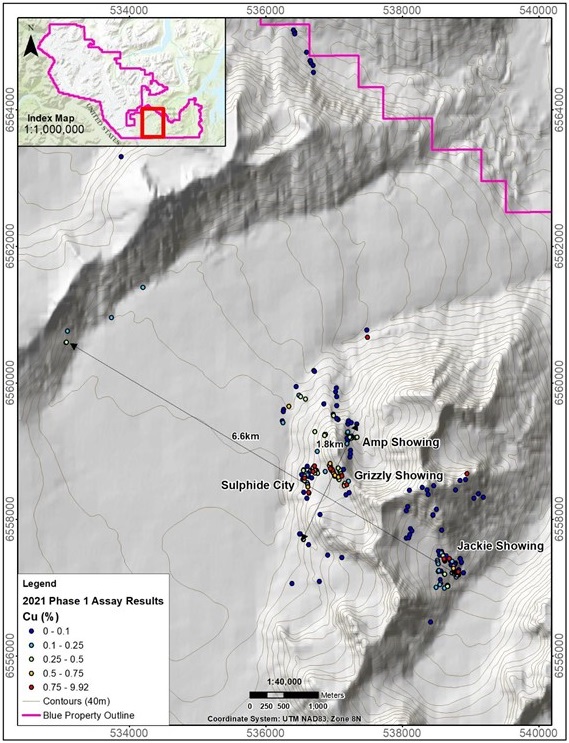
Full size / Figure 1: 2021 Phase 1 sample locations displaying Cu results. (Source)

Full size / Figure 2: 2021 Phase 1 sample locations displaying Ag results. (Source)

Full size / 2021 Phase 1 sample locations displaying Zn results. (Source)
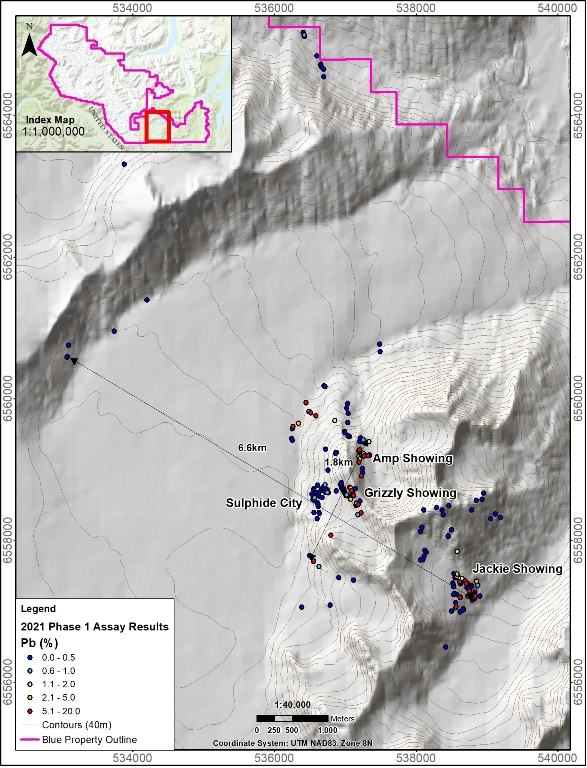
Full size / 2021 Phase 1 sample locations displaying Pb results. (Source)
Property Wide Sampling
Results for property wide reconnaissance sampling executed by Core Assets during Phase 1 of its exploration program revealed the district scale potential of the Blue Property. Strong mineralization was identified in numerous locations across the Property and Core Assets has now confirmed carbonate replacement mineralization at surface over an area 6.6km x 1.8km. A total of 71 outcrop and 11 float samples were collected as part of the Property wide reconnaissance sampling and select assay results are displayed in Table 1. These results prompted the recent staking expansion of the Blue Property.
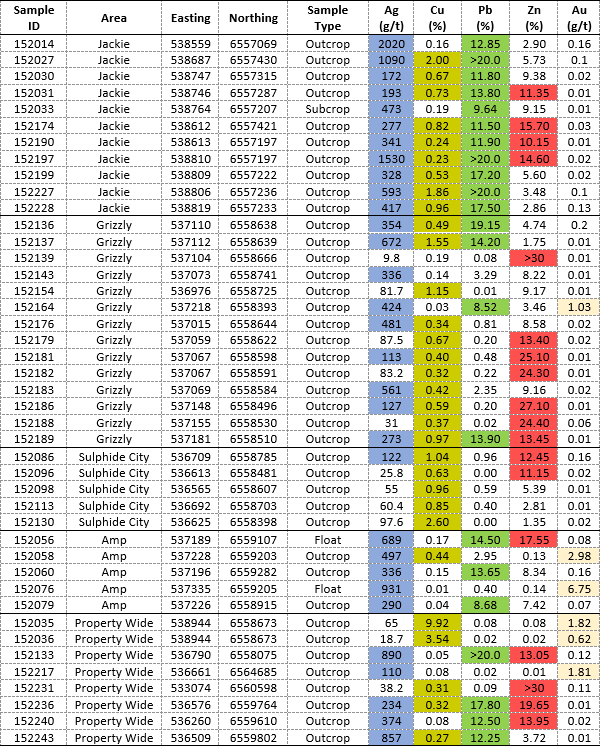
Full size / Table 1: Select Assay Results from Phase 1 Exploration Program (see link to full results here)
About the 2021 Phase 1 Field Program
The helicopter supported ground program was executed during the last two weeks of July, 2021. A crew of four geologists were based in Atlin, BC and utilized Discovery Helicopters for daily access to the Property. The program focused on verification sampling of historically documented mineralization at the Silver Lime Prospect as well as reconnaissance prospecting of the Company’s newly staked ground to the west of the prospect (see Company news release dated June 11, 2021). A total of 247 grab samples (see select samples in Table 1) were collected from the Property over the duration of the program. The historically mapped and sampled massive sulphide carbonate replacement occurrences were located and resampled at the Silver Lime Prospect. Multiple days were also spent traversing locations to the north and west of the Silver Lime Prospect in an attempt to locate additional massive sulphide carbonate replacement mineralization. Based on the carbonate replacement-porphyry model, mineralization should be continuous and zoned from a central porphyry source. Therefore, crews focused on extending mineralization of the carbonate replacement occurrences at the Silver Lime Prospect and searching for typical porphyry style alterations.
Nicholas Rodway, P.Geo, (Licence # 46541) is President, CEO and Director of the Company, and qualified person as defined by National Instrument 43-101. Mr. Rodway supervised the preparation of the technical information in this news release. Neither the Canadian Securities Exchange nor its Regulation Services Provider (as that term is defined in the policies of the CSE) accepts responsibility for the adequacy or accuracy of this release. FORWARD LOOKING STATEMENTS: Statements in this document which are not purely historical are forward-looking statements, including any statements regarding beliefs, plans, expectations, or intentions regarding the future. Forward looking statements in this news release include its goals and scope; that the limestone bodies in the area are favourable for allowing transportation of mineralized carbonate replacement fluids; that the Atlin property is prospective for Iron-Zinc-Lead-and Silver ; that we can become a district scale explorer; that Core Assets will drill in 2022; that the Blue Property has substantial opportunities for a discovery and development; that work on the Blue Property could potentially lead to a new porphyry/CRD style discovery; and that there may be a commercially viable gold or other mineral deposit on our claims. It is important to note that the Company‘s actual business outcomes and exploration results could differ materially from those in such forward-looking statements. Risks and uncertainties include that further permits may not be granted timely or at all; the mineral claims may prove to be unworthy of further expenditure; there may not be an economic mineral resource; methods we thought would be effective may not prove to be in practice or on our claims; economic, competitive, governmental, environmental and technological factors may affect the Company‘s operations, markets, products and prices; our specific plans and timing drilling, field work and other plans may change; we may not have access to or be able to develop any minerals because of cost factors, type of terrain, or availability of equipment and technology; and we may also not raise sufficient funds to carry out our plans. Additional risk factors are discussed in the section entitled “Risk Factors“ in the Company‘s Management Discussion and Analysis for its recently completed fiscal period, which is available under Company‘s SEDAR profile at www.sedar.com. Except as required by law, we will not update these forward looking statement risk factors. [Source]
Example: The Deer Trail Porphyry-CRD Project (USA)
According to the Deer Trail project operator MAG Silver Corp. (TSX: MAG; market capitalization: $2 billion CAD):
“The silver-rich Deer Trail Carbonate Replacement Deposit (CRD) Project in Piute County, Utah encompasses the historic Deer Trail Mine and the adjoining Alunite Ridge area (approximately 5,700 Ha [57 km2]). MAG has consolidated these properties for the first time since the early 1980s, allowing us to apply an integrated district-scale exploration approach based on the continuum of mineralization styles from CRD through Skarn to Porphyry Copper-Molybdenum shown by many related systems worldwide. This model suggests that the high-grade silver, gold, lead, zinc and copper CRD sulphides of the Deer Trail Mine are linked by continuous mineralization to a Porphyry Copper-Molybdenum centre at some distance from the mine. Initial work has focused on tracing the known high-grade CRD mineralization of the historic mine to depth into more favorable host rocks while surface work is tightening localization of the probable porphyry intrusive source for the system.“

Full size / Click here to watch the “Deer Trail Technical Presentation“ on CRDs (starting after 10 minutes) and the Deer Trail CRD Project in Utah, USA, operated by MAG Silver: “Mineralization manifests as scabs, chimneys and mantos. These are zoned in many cases over multiple kilometres from the source. Again, this demonstrates the continuity. Mineralization is continuous all the way back to the source/intrusion.“
“MAG’s exploration focus is to seek the source of the historically mined high-grade Silver-Lead-Zinc-Copper-Gold Deer Trail manto in the thick section of high-potential limestone host (Redwall Limestone) that regional mapping indicates lies just below the interlayered sedimentary and limestone sequence that hosts the Deer Trail mine. This involves: verifying the presence of those potentially more favorable host rocks at depth; projecting the feeder structures of the known CRD mineralization to depth into these inferred underlying limestone host rocks; and seeking large-scale silver-rich massive sulfide replacements and potentially mineralized skarn in them. A deep-looking underground 2-D seismic survey was completed in October 2020 to assist in determining projected depth and geometry of the inferred favorable host rocks, and to help refine final drill hole angles and depths for holes in the Phase I drill program."
“One of the first things we want to do when we‘re exploring anything is to figure out whether the system is a giant or not. One of the things we‘ve learned when looking at big CRDs worldwide is they all show these features in common. There are 13 features on the list here, but it‘s really only the top 3 that really matter for early-stage exploration. If you can‘t tick these [3] boxes it doesn‘t matter whether you can tick the others. So you start with Location: You want to be on “Main Street“ of a CRD/Porphyry belt. And you want to be at the top of the carbonate section so the thing has room to grow. And in a situation like MAG Silver, what you really care about is the silver grades: You want to see high silver grades, better than 400 g/t as soon as you possibly can. The rest of these features are important but these [3] are the ones that get you excited and get you kicked-off on a new project...“ (Source: MAG Silver presentation)
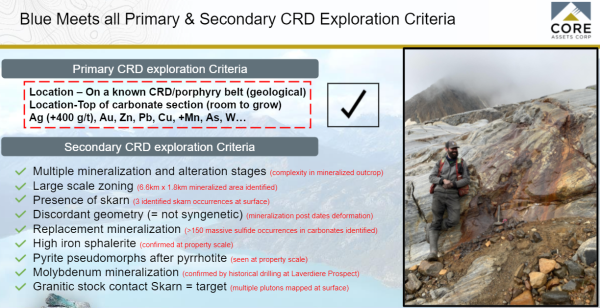
Full size / Core Assets‘ Blue Property is a rare opportunity for both a high-grade, district-scale CRD (silver-lead-zinc-gold) and copper porphyry discovery. Compellingly, the Blue Property checks all the boxes of hosting a carbonate replacement deposit (CRD) distal to a porphyry. Core Assets‘ exploration plan is to trace CRD mineralization discovered at surface back to the source of a porphyry intrusive stock, which can be barren or enriched with copper and sometimes also with gold or molybdenum. (Source)
“When we stack up the porphyry and CRD systems of the world, we see a continuum shown by metal content and also by the style of mineralization in an intrusive relationship. What we are showing with the colour scheme here is a transition from copper-moly to copper to zinc to lead-silver to silver-manganese to gold-silica. This is a typical kind of zoning pattern that you see. It‘s important to recognize that all of these metals are present throughout the full spectrum – it‘s just the dominant metal tends to change as you work your way from the source up... From an exploration standpoint, if you are in the manto zone, you‘re trying to figure out where the source/stock is – if you‘re in the source/stock zone, you want to figure out where those mantos were going. An important thing to take away from this diagram: The really big systems – like Bingham, Grasberg, Sunnyside-Taylor, Santa Eulalia, San Martin – these systems show a very large part of this entire spectrum. The biggest systems cover it from one end to the other.“ (Source: MAG Silver Corp.‘s “Deer Trail Technical Presentation”)
“One other thing to take away ... very seldom only one manto. Sort of two end-members for these, one of which I call the “Skeletal Hand“ Model because you end up with a wrist (in this case with...) a weak porphyry system but with a series of parallel mantos showing a district-wide zonation [fingers]... Note the scale here: 4 km for these enormous high-grade ore bodies. The other end-member is what I call the “Hub & Spoke“ Model and Bingham Canyon demonstrates that beautifully. Everybody knows Bingham Canyon... it‘s one of the world‘s best porphyry copper mines. But people don‘t necessarily remember, or maybe never knew, is that Bingham is completely surrounded by high-grade lead-zinc-silver-copper carbonate replacement and skarn mineralization. A lot of these bodies were mined 60 years before they even started thinking about mining the porphyry.“ (Source: MAG Silver presentation)
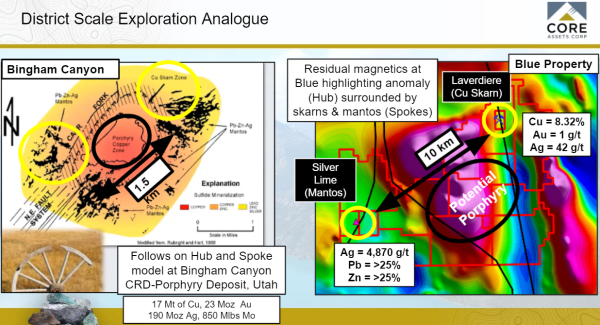
Full size / The Bingham Canyon Mine is an open-pit mining operation extracting a large porphyry copper deposit in Utah, USA. The mine is the largest man-made excavation, and deepest open-pit mine in the world, which is considered to have produced more copper than any other mine in history – more than 19 million tons. The mine is owned by Rio Tinto Group. Bingham Canyon has been in production since 1906 and has resulted in the creation of a pit over 1,210 m deep, 4 km wide; 7.7 km2. (Source)
“Consolidating the [Deer Trail] property package allows MAG to apply its integrated district scale exploration model and apply new technology to the search for an entire suite of mineralization styles expected to occur on the property.“
The following shows how expensive it can get to consolidate and earn-into a 57 km2 land package around the historic Deer Trail Mine (note that Core Assets‘ Blue Property has been expanded to 1083 km2 with the company owning 100% – no earn-in agreements, royalty-free):
“MAG executed an earn-in agreement (the “Agreement”) effective December 20th, 2018 to consolidate and acquire 100% of the historic Deer Trail Mine and surrounding Alunite Ridge area in Piute County, Utah (the “Deer Trail Project”). The counterparties to the Agreement (the “Parties”) contributed their respective Deer Trail claims and property rights to a newly formed company for a 99% interest in the company, with MAG holding the other 1% interest. MAG is the Project Operator and has the right to earn a 100% interest in the company and the Deer Trail Project, with the Parties retaining a 2% NSR. In order to earn in 100%, MAG must make a total of $30 million in escalating annual expenditures ($5,909K expended to March 31, 2021) and $2 million in royalty payments ($300K paid to March 31, 2021), both over 10 years, which commenced December 2018. The combined optional annual commitments do not exceed $2.5 million/year until after 2025. All minimum obligatory commitments under the Agreement have been satisfied...“
In MAG Silver‘s “Deer Trail Technical Presentation“, the company‘s Chief Exploration Officer, Dr. Peter Megaw, commented about the importance of a single company controlling a large-enough land package to conduct district-scale exploration for such extensive CRD-porphyry systems: “By consolidating the land package we are able to explore our entire continuum model for carbonate replacements of the historic Deer Trail mine through the suspected skarns into the porphyry. We control enough of the ground that we have the whole spectrum under control and we get to bring new technologies, ideas and information to a district-scale play...“
Dr. Peter Megaw
The CRD Exploration Model evolved from Dr. Peter Megaw‘s PhD studies at the Santa Eulalia CRD Mining District – the model has been repeatedly validated worldwide as it has been the basis for a number of CRD discoveries in North America in the past decade, including Arizona Mining’s Taylor Deposit, MAG Silver’s Cinco de Mayo amongst others. Using this model, Dr. Megaw has an exceptional track record of CRD discoveries. With 35 years of involvement in Mexican geology, he has become well-known in the Mexican mining industry and is a frequent speaker at international academic and technical symposia. His Ph.D. work at the University of Arizona was an exploration-focused geological/ geochemical study of the Santa Eulalia Ag-Pb-Zn District, Chihuahua and Carbonate Replacement Deposits (CRDs) in general. He has published extensively on CRDs in both geological and mineralogical journals and books. Peter’s primary exploration focus are CRDs and Epithermal Vein Deposits and Porphyry Copper Deposits. He and his team are credited with the significant discoveries at Platosa, Durango; Juanicipio-Fresnillo, Zacatecas; and Cinco de Mayo, Chihuahua. Peter was awarded the Society of Mining Engineers 2012 Robert M. Dreyer Award for excellence in Applied Economic Geology. Peter has been a passionate mineral collector since first setting foot in Santa Eulalia in 1977. He moved to Tucson in 1979 and quickly joined the Tucson Gem and Mineral Society. His mineral collecting has come to focus almost exclusively on Minerals of Mexico. He won the Desautels Trophy in 2006 for the Best Case of Minerals at the Tucson Show for a case of Mexican Minerals. He has also three times been awarded the Romero Trophy for the best Mexican specimen on exhibit in the Tucson Show. His mineralogical writing has also been rewarded: he was the first recipient of the FM Student Paper Award in 1985 with his paper on the mineralogy of the East Camp of Santa Eulalia; in 2003 he was co-recipient with Tom Moore of FM’s Best Paper in Mineralogical Record award for their article on the Ojuela Mine, Mapimi, Durango Mexico; and he received the 2010 FM Best Paper in extraLapis award for his article on “The Geology and Genesis of (most) Collectible Smithsonite.” He has written for Mineral News since its inception and is a consulting editor and occasional author for Rocks and Minerals. He is photo-moderator for submissions on Mexico to Mindat and co-moderator of the FMF Mineral Forum, often with tongue planted firmly in cheek. A combination of the above led him to be awarded the Carnegie Mineralogical Award for 2009. Megaw-Publications: www.researchgate.net/profile/Peter-MegawPrevious Coverage

Full size / Pictures above and below: Nick Rodway (Core Assets’ CEO & President) identifying and sampling heavily mineralized CRD outcrops during the recently completed phase-1 grab-sampling exploration program (assays announced today) at the Blue Property in northern British Columbia, Canada. (Source)
Previous Rockstone Coverage
Report #5: “Retreating ice uncovers major discovery potential for CRD-Porphyry system at district-scale Blue Property, BC“ (Web Version / PDF)
Report #4: “The Silver-Copper Super-Cycle“ (Web Version / PDF)
Report 3: “The Llewelyn Fault Zone: A district-scale plumbing system analog to other prolific mining and exploration camps in the Golden Triangle?“ (Web Version / PDF)
Report 2: “On a Mission to Become the Premier Copper-Gold Porphyry Explorer of the Northernmost Extent of the Golden Triangle“ (Web Version / PDF)
Report 1: “Perfect Time to Reshape the Golden Triangle in British Columbia“ (Web Version / PDF)
Company Details

Core Assets Corp.
Suite 1450 – 789 West Pender Street
Vancouver, BC, V6C 1H2 Canada
Phone: +1 604 681 1568
Email: info@coreassetscorp.com
www.coreassetscorp.com
Incorporation Date: April 20, 2016
Listing Date: July 27, 2020
CUSIP: 21871U05 / ISIN: CA21871U1057
Shares Issued & Outstanding: 55,709,701
Options: 3,635,000 / Warrants: 17,842,737
Fully Diluted: 77,187,438
Canadian Symbol (CSE): CC
Current Price: $0.335 CAD (09/24/2021)
Market Capitalization: $19 Million CAD
German Symbol / WKN: 5RJ / A2QCCU
Current Price: €0.206 (09/24/2021)
Market Capitalization: €12 Million EUR
Contact:
Rockstone Research
Stephan Bogner (Dipl. Kfm.)
8260 Stein am Rhein, Switzerland
Phone: +41-44-5862323
Email: info@rockstone-research.com
www.rockstone-research.com
Disclaimer: This report contains forward-looking information or forward-looking statements (collectively "forward-looking information") within the meaning of applicable securities laws. Forward-looking information is typically identified by words such as: "believe", "expect", "anticipate", "intend", "estimate", "potentially" and similar expressions, or are those, which, by their nature, refer to future events. Rockstone Research, Core Assets Corp. and Zimtu Capital Corp. caution investors that any forward-looking information provided herein is not a guarantee of future results or performance, and that actual results may differ materially from those in forward-looking information as a result of various factors. The reader is referred to Core Assets Corp.´s public filings for a more complete discussion of such risk factors and their potential effects which may be accessed through its profile on SEDAR at www.sedar.com. Please read the full disclaimer within the full research report as a PDF (here) as fundamental risks and conflicts of interest exist. The author, Stephan Bogner, holds an equity position in Core Assets Corp.,as well as in Zimtu Capital Corp., and is being paid by Zimtu Capital Corp. for the preparation, publication and distribution of this report, whereas Zimtu Capital Corp. also holds a long position in Core Assets Corp. Note that Core Assets Corp. pays Zimtu Capital Corp. to provide this report and other investor awareness services. Zimtu Capital Corp. is an insider and control block of Core Assets Corp. by virtue of owning more than 20% of Core’s outstanding stock. Core Assets Corp. has one or more common directors with Zimtu Capital Corp.







